Contemporary Counselling: A Detailed Comparison of REBT and CT
VerifiedAdded on 2023/06/13
|9
|3310
|468
Essay
AI Summary
This essay provides a detailed comparative analysis of Rational Emotive Behavior Therapy (REBT) and Cognitive Therapy (CT) within the context of contemporary behavioral and cognitive counseling. It outlines and evaluates the core principles, therapeutic relationships, applications, and processes of both therapies. The essay highlights the similarities, such as their focus on conscious thought and present difficulties, and differences, including REBT's directive approach versus CT's emphasis on internal dialogue. Specific applications of REBT, such as group and individual therapy, and CT, like its effectiveness in treating depression and anxiety, are discussed. The initial phases of both therapies are compared, noting REBT's focus on problem identification and CT's emphasis on outlining the therapeutic process. The essay concludes by underscoring the unique contributions of each therapy to the field of mental health treatment, offering a comprehensive understanding of their theoretical underpinnings and practical applications.
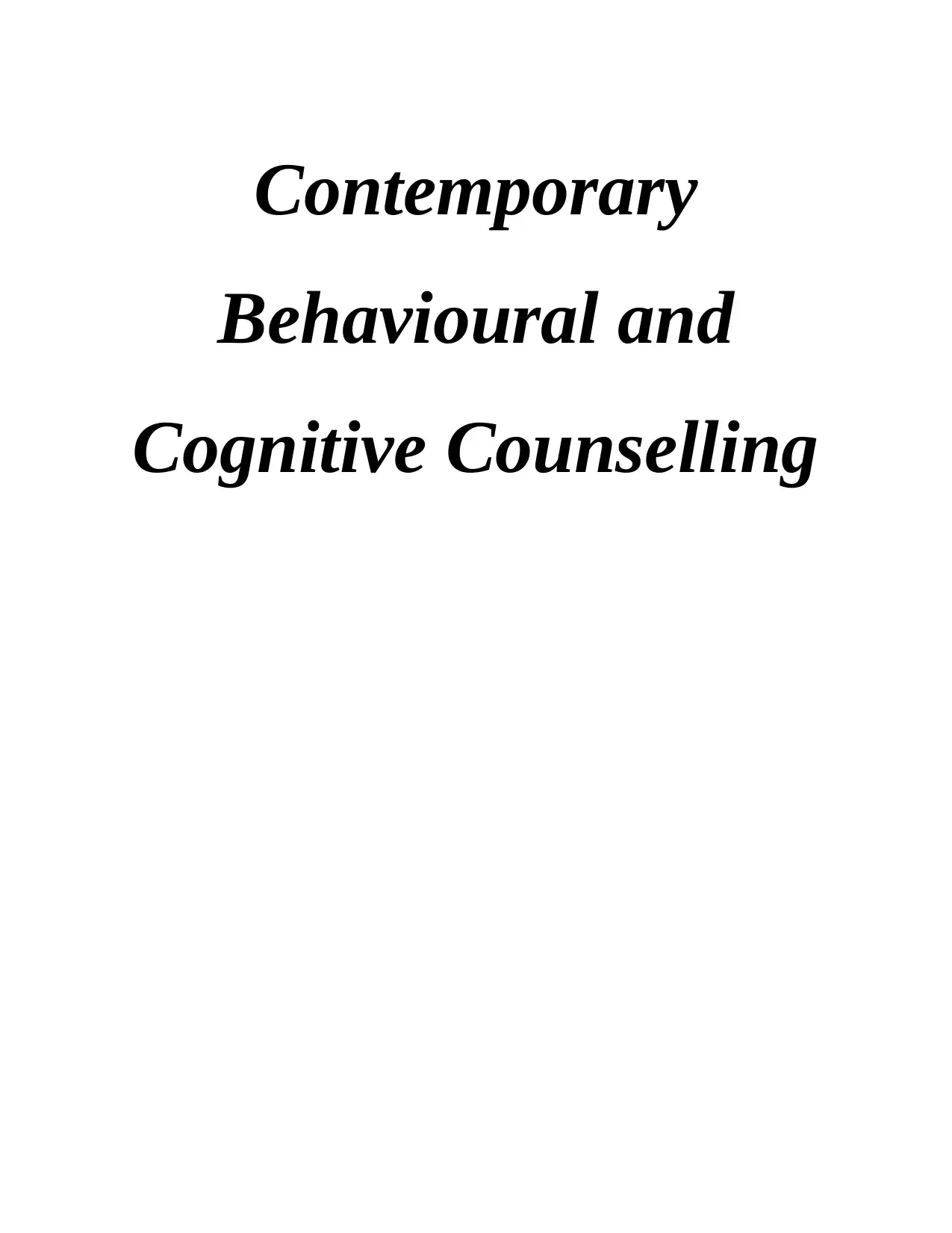
Contemporary
Behavioural and
Cognitive Counselling
Behavioural and
Cognitive Counselling
Paraphrase This Document
Need a fresh take? Get an instant paraphrase of this document with our AI Paraphraser
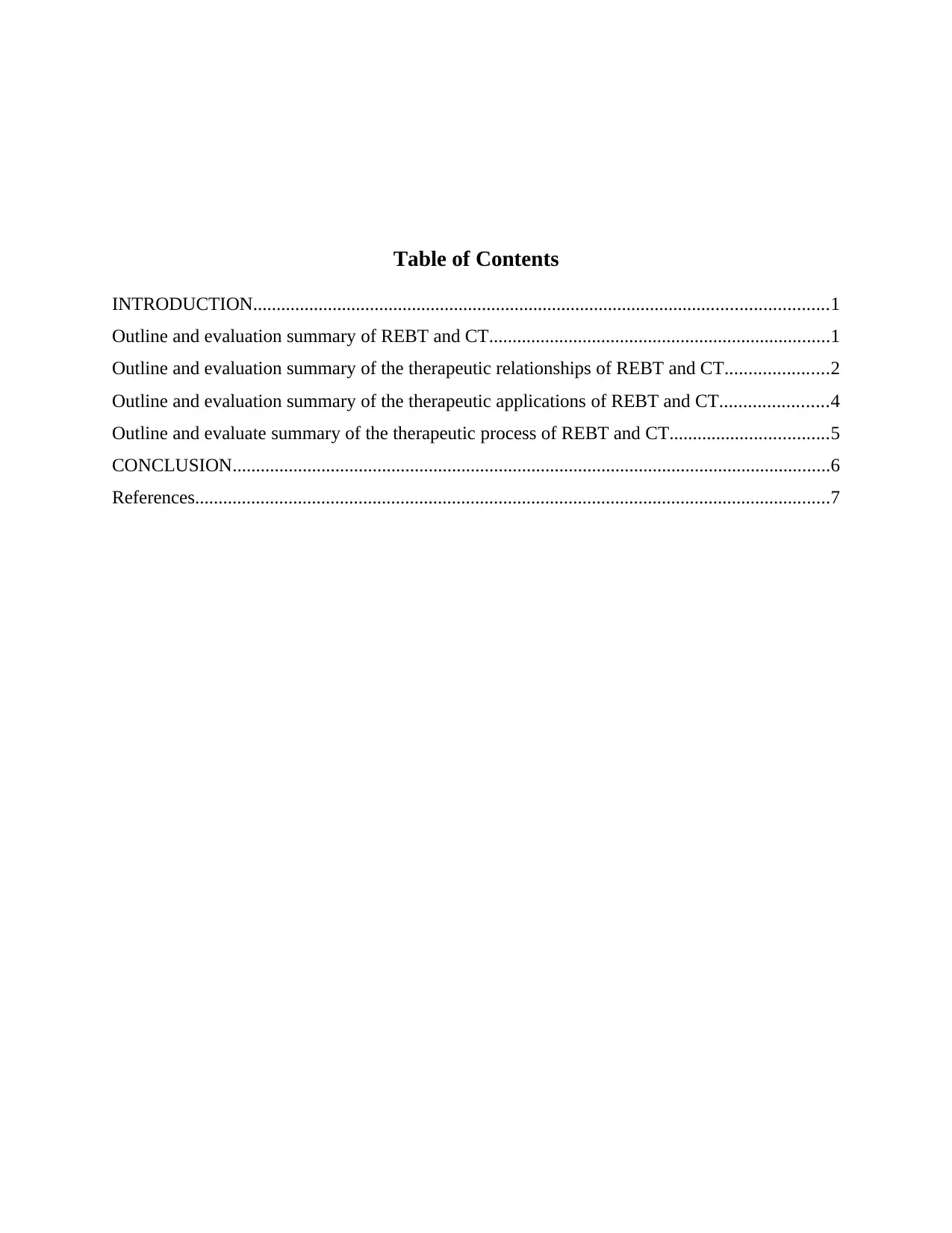
Table of Contents
INTRODUCTION...........................................................................................................................1
Outline and evaluation summary of REBT and CT.........................................................................1
Outline and evaluation summary of the therapeutic relationships of REBT and CT......................2
Outline and evaluation summary of the therapeutic applications of REBT and CT.......................4
Outline and evaluate summary of the therapeutic process of REBT and CT..................................5
CONCLUSION................................................................................................................................6
References........................................................................................................................................7
INTRODUCTION...........................................................................................................................1
Outline and evaluation summary of REBT and CT.........................................................................1
Outline and evaluation summary of the therapeutic relationships of REBT and CT......................2
Outline and evaluation summary of the therapeutic applications of REBT and CT.......................4
Outline and evaluate summary of the therapeutic process of REBT and CT..................................5
CONCLUSION................................................................................................................................6
References........................................................................................................................................7
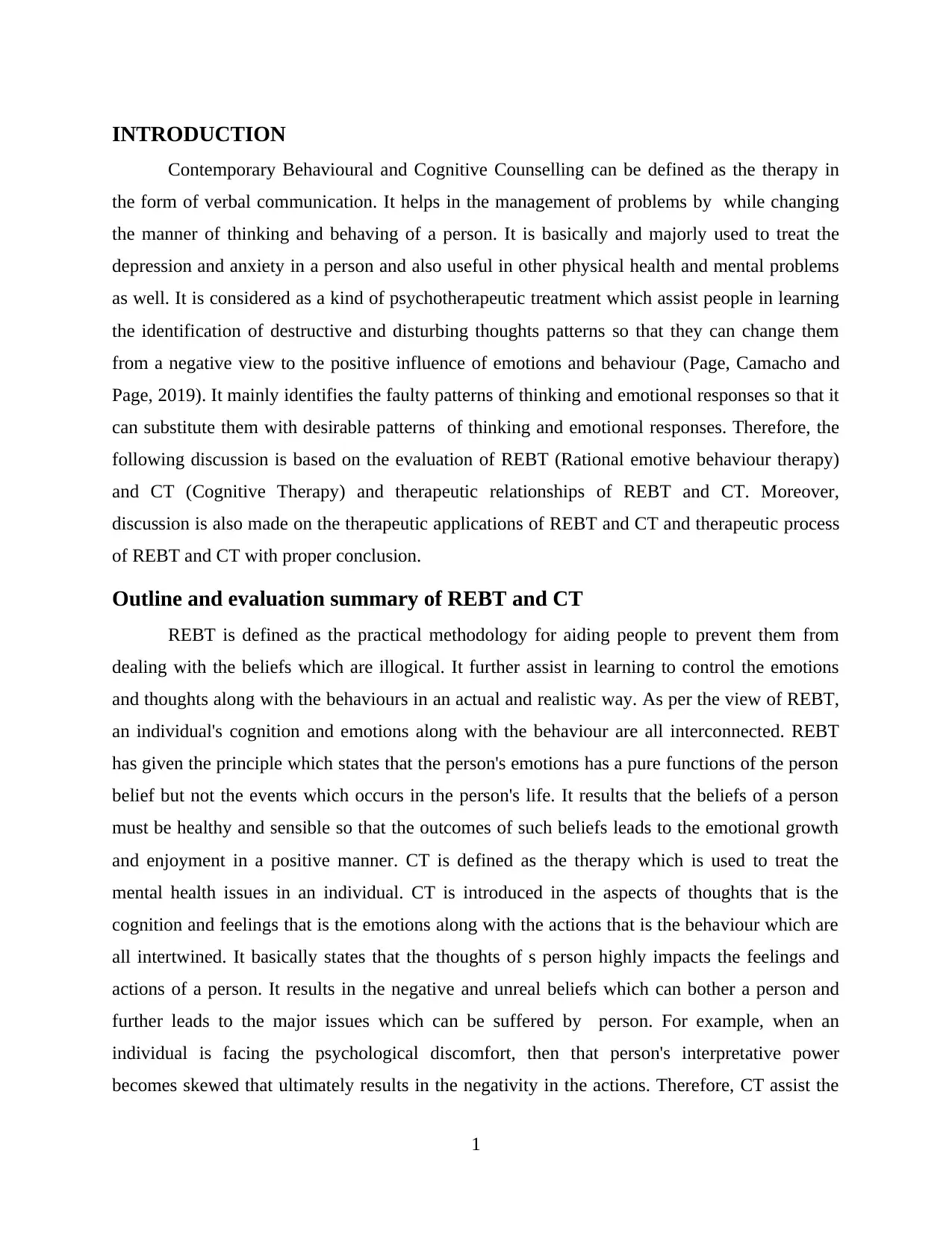
INTRODUCTION
Contemporary Behavioural and Cognitive Counselling can be defined as the therapy in
the form of verbal communication. It helps in the management of problems by while changing
the manner of thinking and behaving of a person. It is basically and majorly used to treat the
depression and anxiety in a person and also useful in other physical health and mental problems
as well. It is considered as a kind of psychotherapeutic treatment which assist people in learning
the identification of destructive and disturbing thoughts patterns so that they can change them
from a negative view to the positive influence of emotions and behaviour (Page, Camacho and
Page, 2019). It mainly identifies the faulty patterns of thinking and emotional responses so that it
can substitute them with desirable patterns of thinking and emotional responses. Therefore, the
following discussion is based on the evaluation of REBT (Rational emotive behaviour therapy)
and CT (Cognitive Therapy) and therapeutic relationships of REBT and CT. Moreover,
discussion is also made on the therapeutic applications of REBT and CT and therapeutic process
of REBT and CT with proper conclusion.
Outline and evaluation summary of REBT and CT
REBT is defined as the practical methodology for aiding people to prevent them from
dealing with the beliefs which are illogical. It further assist in learning to control the emotions
and thoughts along with the behaviours in an actual and realistic way. As per the view of REBT,
an individual's cognition and emotions along with the behaviour are all interconnected. REBT
has given the principle which states that the person's emotions has a pure functions of the person
belief but not the events which occurs in the person's life. It results that the beliefs of a person
must be healthy and sensible so that the outcomes of such beliefs leads to the emotional growth
and enjoyment in a positive manner. CT is defined as the therapy which is used to treat the
mental health issues in an individual. CT is introduced in the aspects of thoughts that is the
cognition and feelings that is the emotions along with the actions that is the behaviour which are
all intertwined. It basically states that the thoughts of s person highly impacts the feelings and
actions of a person. It results in the negative and unreal beliefs which can bother a person and
further leads to the major issues which can be suffered by person. For example, when an
individual is facing the psychological discomfort, then that person's interpretative power
becomes skewed that ultimately results in the negativity in the actions. Therefore, CT assist the
1
Contemporary Behavioural and Cognitive Counselling can be defined as the therapy in
the form of verbal communication. It helps in the management of problems by while changing
the manner of thinking and behaving of a person. It is basically and majorly used to treat the
depression and anxiety in a person and also useful in other physical health and mental problems
as well. It is considered as a kind of psychotherapeutic treatment which assist people in learning
the identification of destructive and disturbing thoughts patterns so that they can change them
from a negative view to the positive influence of emotions and behaviour (Page, Camacho and
Page, 2019). It mainly identifies the faulty patterns of thinking and emotional responses so that it
can substitute them with desirable patterns of thinking and emotional responses. Therefore, the
following discussion is based on the evaluation of REBT (Rational emotive behaviour therapy)
and CT (Cognitive Therapy) and therapeutic relationships of REBT and CT. Moreover,
discussion is also made on the therapeutic applications of REBT and CT and therapeutic process
of REBT and CT with proper conclusion.
Outline and evaluation summary of REBT and CT
REBT is defined as the practical methodology for aiding people to prevent them from
dealing with the beliefs which are illogical. It further assist in learning to control the emotions
and thoughts along with the behaviours in an actual and realistic way. As per the view of REBT,
an individual's cognition and emotions along with the behaviour are all interconnected. REBT
has given the principle which states that the person's emotions has a pure functions of the person
belief but not the events which occurs in the person's life. It results that the beliefs of a person
must be healthy and sensible so that the outcomes of such beliefs leads to the emotional growth
and enjoyment in a positive manner. CT is defined as the therapy which is used to treat the
mental health issues in an individual. CT is introduced in the aspects of thoughts that is the
cognition and feelings that is the emotions along with the actions that is the behaviour which are
all intertwined. It basically states that the thoughts of s person highly impacts the feelings and
actions of a person. It results in the negative and unreal beliefs which can bother a person and
further leads to the major issues which can be suffered by person. For example, when an
individual is facing the psychological discomfort, then that person's interpretative power
becomes skewed that ultimately results in the negativity in the actions. Therefore, CT assist the
1
⊘ This is a preview!⊘
Do you want full access?
Subscribe today to unlock all pages.

Trusted by 1+ million students worldwide
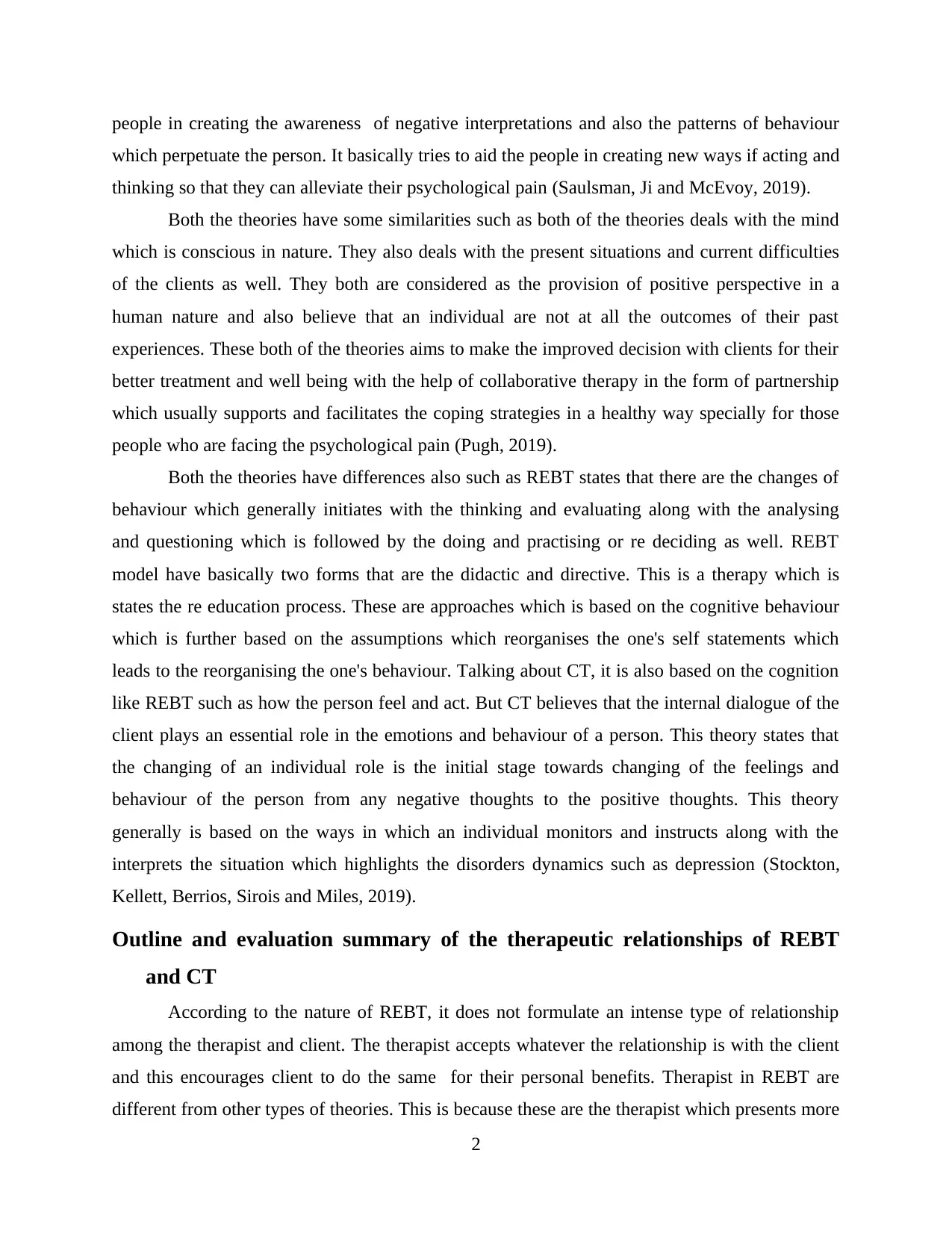
people in creating the awareness of negative interpretations and also the patterns of behaviour
which perpetuate the person. It basically tries to aid the people in creating new ways if acting and
thinking so that they can alleviate their psychological pain (Saulsman, Ji and McEvoy, 2019).
Both the theories have some similarities such as both of the theories deals with the mind
which is conscious in nature. They also deals with the present situations and current difficulties
of the clients as well. They both are considered as the provision of positive perspective in a
human nature and also believe that an individual are not at all the outcomes of their past
experiences. These both of the theories aims to make the improved decision with clients for their
better treatment and well being with the help of collaborative therapy in the form of partnership
which usually supports and facilitates the coping strategies in a healthy way specially for those
people who are facing the psychological pain (Pugh, 2019).
Both the theories have differences also such as REBT states that there are the changes of
behaviour which generally initiates with the thinking and evaluating along with the analysing
and questioning which is followed by the doing and practising or re deciding as well. REBT
model have basically two forms that are the didactic and directive. This is a therapy which is
states the re education process. These are approaches which is based on the cognitive behaviour
which is further based on the assumptions which reorganises the one's self statements which
leads to the reorganising the one's behaviour. Talking about CT, it is also based on the cognition
like REBT such as how the person feel and act. But CT believes that the internal dialogue of the
client plays an essential role in the emotions and behaviour of a person. This theory states that
the changing of an individual role is the initial stage towards changing of the feelings and
behaviour of the person from any negative thoughts to the positive thoughts. This theory
generally is based on the ways in which an individual monitors and instructs along with the
interprets the situation which highlights the disorders dynamics such as depression (Stockton,
Kellett, Berrios, Sirois and Miles, 2019).
Outline and evaluation summary of the therapeutic relationships of REBT
and CT
According to the nature of REBT, it does not formulate an intense type of relationship
among the therapist and client. The therapist accepts whatever the relationship is with the client
and this encourages client to do the same for their personal benefits. Therapist in REBT are
different from other types of theories. This is because these are the therapist which presents more
2
which perpetuate the person. It basically tries to aid the people in creating new ways if acting and
thinking so that they can alleviate their psychological pain (Saulsman, Ji and McEvoy, 2019).
Both the theories have some similarities such as both of the theories deals with the mind
which is conscious in nature. They also deals with the present situations and current difficulties
of the clients as well. They both are considered as the provision of positive perspective in a
human nature and also believe that an individual are not at all the outcomes of their past
experiences. These both of the theories aims to make the improved decision with clients for their
better treatment and well being with the help of collaborative therapy in the form of partnership
which usually supports and facilitates the coping strategies in a healthy way specially for those
people who are facing the psychological pain (Pugh, 2019).
Both the theories have differences also such as REBT states that there are the changes of
behaviour which generally initiates with the thinking and evaluating along with the analysing
and questioning which is followed by the doing and practising or re deciding as well. REBT
model have basically two forms that are the didactic and directive. This is a therapy which is
states the re education process. These are approaches which is based on the cognitive behaviour
which is further based on the assumptions which reorganises the one's self statements which
leads to the reorganising the one's behaviour. Talking about CT, it is also based on the cognition
like REBT such as how the person feel and act. But CT believes that the internal dialogue of the
client plays an essential role in the emotions and behaviour of a person. This theory states that
the changing of an individual role is the initial stage towards changing of the feelings and
behaviour of the person from any negative thoughts to the positive thoughts. This theory
generally is based on the ways in which an individual monitors and instructs along with the
interprets the situation which highlights the disorders dynamics such as depression (Stockton,
Kellett, Berrios, Sirois and Miles, 2019).
Outline and evaluation summary of the therapeutic relationships of REBT
and CT
According to the nature of REBT, it does not formulate an intense type of relationship
among the therapist and client. The therapist accepts whatever the relationship is with the client
and this encourages client to do the same for their personal benefits. Therapist in REBT are
different from other types of theories. This is because these are the therapist which presents more
2
Paraphrase This Document
Need a fresh take? Get an instant paraphrase of this document with our AI Paraphraser
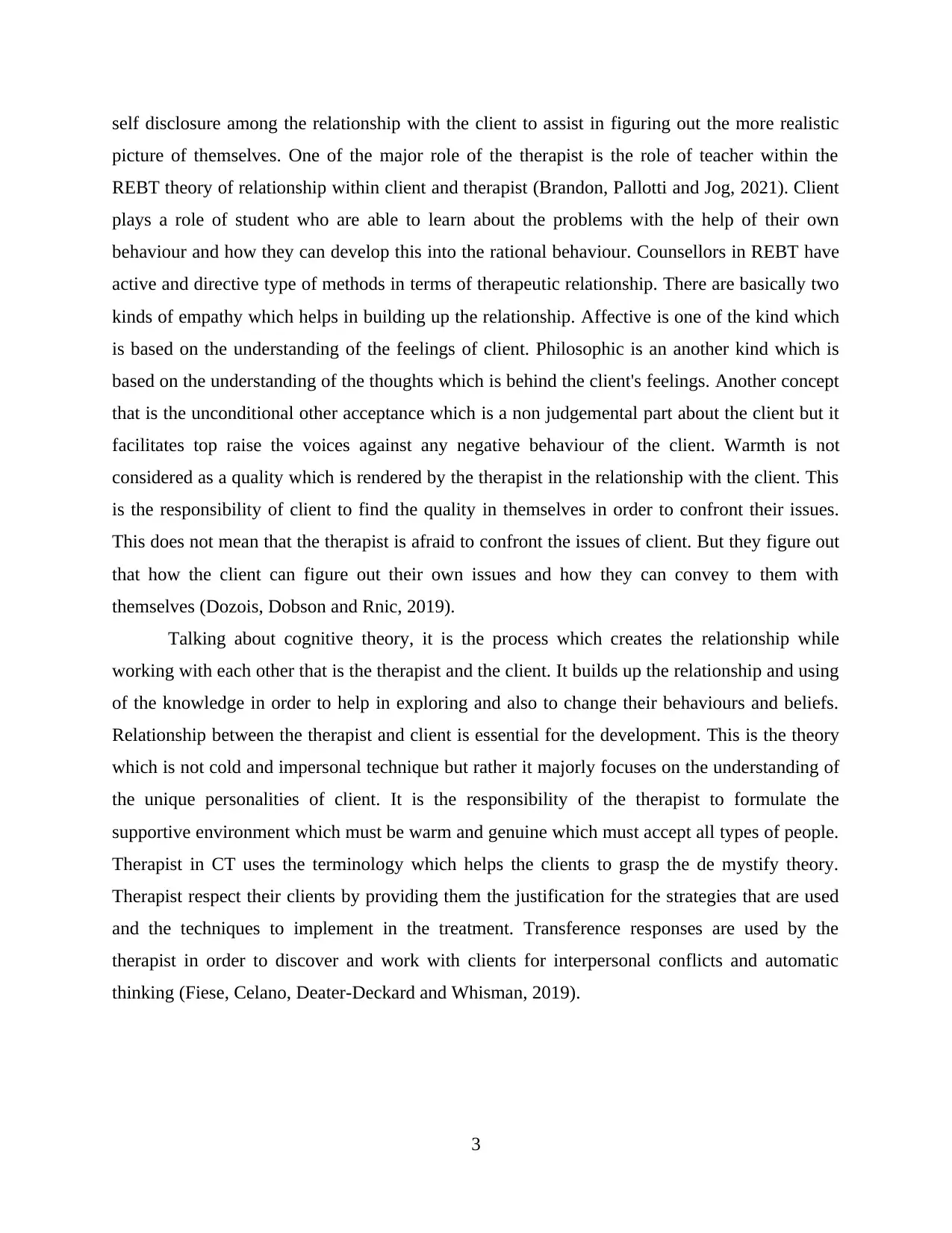
self disclosure among the relationship with the client to assist in figuring out the more realistic
picture of themselves. One of the major role of the therapist is the role of teacher within the
REBT theory of relationship within client and therapist (Brandon, Pallotti and Jog, 2021). Client
plays a role of student who are able to learn about the problems with the help of their own
behaviour and how they can develop this into the rational behaviour. Counsellors in REBT have
active and directive type of methods in terms of therapeutic relationship. There are basically two
kinds of empathy which helps in building up the relationship. Affective is one of the kind which
is based on the understanding of the feelings of client. Philosophic is an another kind which is
based on the understanding of the thoughts which is behind the client's feelings. Another concept
that is the unconditional other acceptance which is a non judgemental part about the client but it
facilitates top raise the voices against any negative behaviour of the client. Warmth is not
considered as a quality which is rendered by the therapist in the relationship with the client. This
is the responsibility of client to find the quality in themselves in order to confront their issues.
This does not mean that the therapist is afraid to confront the issues of client. But they figure out
that how the client can figure out their own issues and how they can convey to them with
themselves (Dozois, Dobson and Rnic, 2019).
Talking about cognitive theory, it is the process which creates the relationship while
working with each other that is the therapist and the client. It builds up the relationship and using
of the knowledge in order to help in exploring and also to change their behaviours and beliefs.
Relationship between the therapist and client is essential for the development. This is the theory
which is not cold and impersonal technique but rather it majorly focuses on the understanding of
the unique personalities of client. It is the responsibility of the therapist to formulate the
supportive environment which must be warm and genuine which must accept all types of people.
Therapist in CT uses the terminology which helps the clients to grasp the de mystify theory.
Therapist respect their clients by providing them the justification for the strategies that are used
and the techniques to implement in the treatment. Transference responses are used by the
therapist in order to discover and work with clients for interpersonal conflicts and automatic
thinking (Fiese, Celano, Deater-Deckard and Whisman, 2019).
3
picture of themselves. One of the major role of the therapist is the role of teacher within the
REBT theory of relationship within client and therapist (Brandon, Pallotti and Jog, 2021). Client
plays a role of student who are able to learn about the problems with the help of their own
behaviour and how they can develop this into the rational behaviour. Counsellors in REBT have
active and directive type of methods in terms of therapeutic relationship. There are basically two
kinds of empathy which helps in building up the relationship. Affective is one of the kind which
is based on the understanding of the feelings of client. Philosophic is an another kind which is
based on the understanding of the thoughts which is behind the client's feelings. Another concept
that is the unconditional other acceptance which is a non judgemental part about the client but it
facilitates top raise the voices against any negative behaviour of the client. Warmth is not
considered as a quality which is rendered by the therapist in the relationship with the client. This
is the responsibility of client to find the quality in themselves in order to confront their issues.
This does not mean that the therapist is afraid to confront the issues of client. But they figure out
that how the client can figure out their own issues and how they can convey to them with
themselves (Dozois, Dobson and Rnic, 2019).
Talking about cognitive theory, it is the process which creates the relationship while
working with each other that is the therapist and the client. It builds up the relationship and using
of the knowledge in order to help in exploring and also to change their behaviours and beliefs.
Relationship between the therapist and client is essential for the development. This is the theory
which is not cold and impersonal technique but rather it majorly focuses on the understanding of
the unique personalities of client. It is the responsibility of the therapist to formulate the
supportive environment which must be warm and genuine which must accept all types of people.
Therapist in CT uses the terminology which helps the clients to grasp the de mystify theory.
Therapist respect their clients by providing them the justification for the strategies that are used
and the techniques to implement in the treatment. Transference responses are used by the
therapist in order to discover and work with clients for interpersonal conflicts and automatic
thinking (Fiese, Celano, Deater-Deckard and Whisman, 2019).
3
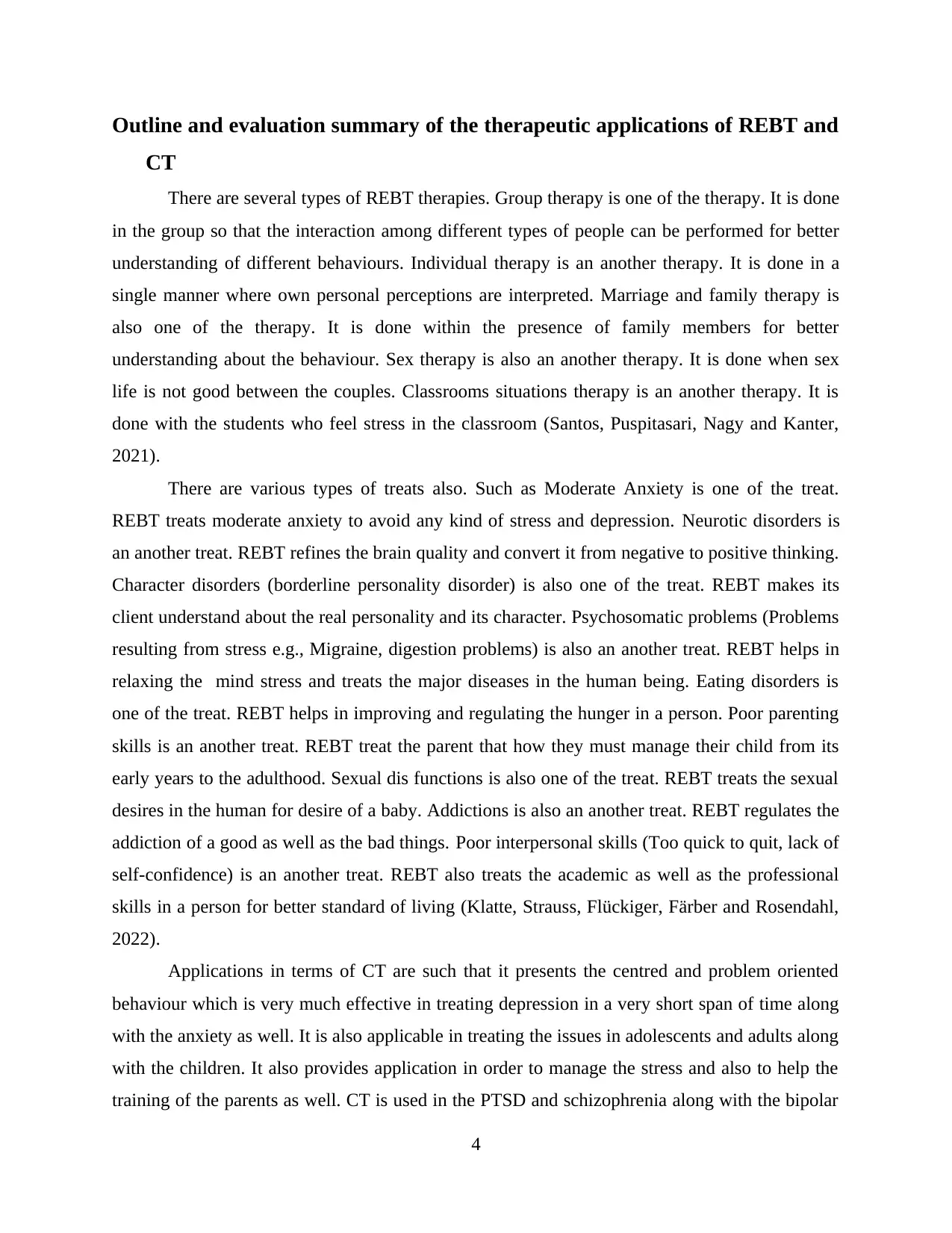
Outline and evaluation summary of the therapeutic applications of REBT and
CT
There are several types of REBT therapies. Group therapy is one of the therapy. It is done
in the group so that the interaction among different types of people can be performed for better
understanding of different behaviours. Individual therapy is an another therapy. It is done in a
single manner where own personal perceptions are interpreted. Marriage and family therapy is
also one of the therapy. It is done within the presence of family members for better
understanding about the behaviour. Sex therapy is also an another therapy. It is done when sex
life is not good between the couples. Classrooms situations therapy is an another therapy. It is
done with the students who feel stress in the classroom (Santos, Puspitasari, Nagy and Kanter,
2021).
There are various types of treats also. Such as Moderate Anxiety is one of the treat.
REBT treats moderate anxiety to avoid any kind of stress and depression. Neurotic disorders is
an another treat. REBT refines the brain quality and convert it from negative to positive thinking.
Character disorders (borderline personality disorder) is also one of the treat. REBT makes its
client understand about the real personality and its character. Psychosomatic problems (Problems
resulting from stress e.g., Migraine, digestion problems) is also an another treat. REBT helps in
relaxing the mind stress and treats the major diseases in the human being. Eating disorders is
one of the treat. REBT helps in improving and regulating the hunger in a person. Poor parenting
skills is an another treat. REBT treat the parent that how they must manage their child from its
early years to the adulthood. Sexual dis functions is also one of the treat. REBT treats the sexual
desires in the human for desire of a baby. Addictions is also an another treat. REBT regulates the
addiction of a good as well as the bad things. Poor interpersonal skills (Too quick to quit, lack of
self-confidence) is an another treat. REBT also treats the academic as well as the professional
skills in a person for better standard of living (Klatte, Strauss, Flückiger, Färber and Rosendahl,
2022).
Applications in terms of CT are such that it presents the centred and problem oriented
behaviour which is very much effective in treating depression in a very short span of time along
with the anxiety as well. It is also applicable in treating the issues in adolescents and adults along
with the children. It also provides application in order to manage the stress and also to help the
training of the parents as well. CT is used in the PTSD and schizophrenia along with the bipolar
4
CT
There are several types of REBT therapies. Group therapy is one of the therapy. It is done
in the group so that the interaction among different types of people can be performed for better
understanding of different behaviours. Individual therapy is an another therapy. It is done in a
single manner where own personal perceptions are interpreted. Marriage and family therapy is
also one of the therapy. It is done within the presence of family members for better
understanding about the behaviour. Sex therapy is also an another therapy. It is done when sex
life is not good between the couples. Classrooms situations therapy is an another therapy. It is
done with the students who feel stress in the classroom (Santos, Puspitasari, Nagy and Kanter,
2021).
There are various types of treats also. Such as Moderate Anxiety is one of the treat.
REBT treats moderate anxiety to avoid any kind of stress and depression. Neurotic disorders is
an another treat. REBT refines the brain quality and convert it from negative to positive thinking.
Character disorders (borderline personality disorder) is also one of the treat. REBT makes its
client understand about the real personality and its character. Psychosomatic problems (Problems
resulting from stress e.g., Migraine, digestion problems) is also an another treat. REBT helps in
relaxing the mind stress and treats the major diseases in the human being. Eating disorders is
one of the treat. REBT helps in improving and regulating the hunger in a person. Poor parenting
skills is an another treat. REBT treat the parent that how they must manage their child from its
early years to the adulthood. Sexual dis functions is also one of the treat. REBT treats the sexual
desires in the human for desire of a baby. Addictions is also an another treat. REBT regulates the
addiction of a good as well as the bad things. Poor interpersonal skills (Too quick to quit, lack of
self-confidence) is an another treat. REBT also treats the academic as well as the professional
skills in a person for better standard of living (Klatte, Strauss, Flückiger, Färber and Rosendahl,
2022).
Applications in terms of CT are such that it presents the centred and problem oriented
behaviour which is very much effective in treating depression in a very short span of time along
with the anxiety as well. It is also applicable in treating the issues in adolescents and adults along
with the children. It also provides application in order to manage the stress and also to help the
training of the parents as well. CT is used in the PTSD and schizophrenia along with the bipolar
4
⊘ This is a preview!⊘
Do you want full access?
Subscribe today to unlock all pages.

Trusted by 1+ million students worldwide
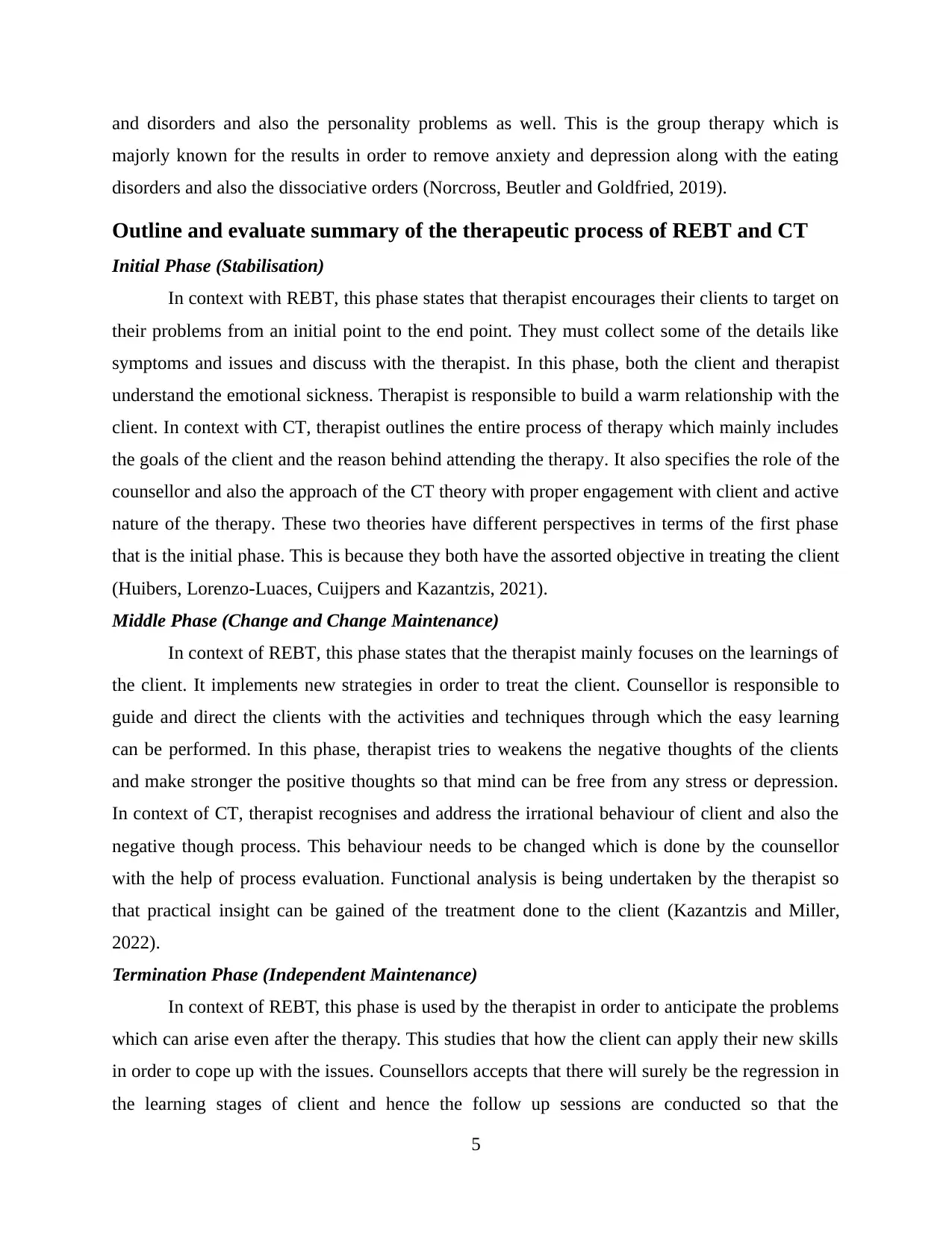
and disorders and also the personality problems as well. This is the group therapy which is
majorly known for the results in order to remove anxiety and depression along with the eating
disorders and also the dissociative orders (Norcross, Beutler and Goldfried, 2019).
Outline and evaluate summary of the therapeutic process of REBT and CT
Initial Phase (Stabilisation)
In context with REBT, this phase states that therapist encourages their clients to target on
their problems from an initial point to the end point. They must collect some of the details like
symptoms and issues and discuss with the therapist. In this phase, both the client and therapist
understand the emotional sickness. Therapist is responsible to build a warm relationship with the
client. In context with CT, therapist outlines the entire process of therapy which mainly includes
the goals of the client and the reason behind attending the therapy. It also specifies the role of the
counsellor and also the approach of the CT theory with proper engagement with client and active
nature of the therapy. These two theories have different perspectives in terms of the first phase
that is the initial phase. This is because they both have the assorted objective in treating the client
(Huibers, Lorenzo-Luaces, Cuijpers and Kazantzis, 2021).
Middle Phase (Change and Change Maintenance)
In context of REBT, this phase states that the therapist mainly focuses on the learnings of
the client. It implements new strategies in order to treat the client. Counsellor is responsible to
guide and direct the clients with the activities and techniques through which the easy learning
can be performed. In this phase, therapist tries to weakens the negative thoughts of the clients
and make stronger the positive thoughts so that mind can be free from any stress or depression.
In context of CT, therapist recognises and address the irrational behaviour of client and also the
negative though process. This behaviour needs to be changed which is done by the counsellor
with the help of process evaluation. Functional analysis is being undertaken by the therapist so
that practical insight can be gained of the treatment done to the client (Kazantzis and Miller,
2022).
Termination Phase (Independent Maintenance)
In context of REBT, this phase is used by the therapist in order to anticipate the problems
which can arise even after the therapy. This studies that how the client can apply their new skills
in order to cope up with the issues. Counsellors accepts that there will surely be the regression in
the learning stages of client and hence the follow up sessions are conducted so that the
5
majorly known for the results in order to remove anxiety and depression along with the eating
disorders and also the dissociative orders (Norcross, Beutler and Goldfried, 2019).
Outline and evaluate summary of the therapeutic process of REBT and CT
Initial Phase (Stabilisation)
In context with REBT, this phase states that therapist encourages their clients to target on
their problems from an initial point to the end point. They must collect some of the details like
symptoms and issues and discuss with the therapist. In this phase, both the client and therapist
understand the emotional sickness. Therapist is responsible to build a warm relationship with the
client. In context with CT, therapist outlines the entire process of therapy which mainly includes
the goals of the client and the reason behind attending the therapy. It also specifies the role of the
counsellor and also the approach of the CT theory with proper engagement with client and active
nature of the therapy. These two theories have different perspectives in terms of the first phase
that is the initial phase. This is because they both have the assorted objective in treating the client
(Huibers, Lorenzo-Luaces, Cuijpers and Kazantzis, 2021).
Middle Phase (Change and Change Maintenance)
In context of REBT, this phase states that the therapist mainly focuses on the learnings of
the client. It implements new strategies in order to treat the client. Counsellor is responsible to
guide and direct the clients with the activities and techniques through which the easy learning
can be performed. In this phase, therapist tries to weakens the negative thoughts of the clients
and make stronger the positive thoughts so that mind can be free from any stress or depression.
In context of CT, therapist recognises and address the irrational behaviour of client and also the
negative though process. This behaviour needs to be changed which is done by the counsellor
with the help of process evaluation. Functional analysis is being undertaken by the therapist so
that practical insight can be gained of the treatment done to the client (Kazantzis and Miller,
2022).
Termination Phase (Independent Maintenance)
In context of REBT, this phase is used by the therapist in order to anticipate the problems
which can arise even after the therapy. This studies that how the client can apply their new skills
in order to cope up with the issues. Counsellors accepts that there will surely be the regression in
the learning stages of client and hence the follow up sessions are conducted so that the
5
Paraphrase This Document
Need a fresh take? Get an instant paraphrase of this document with our AI Paraphraser
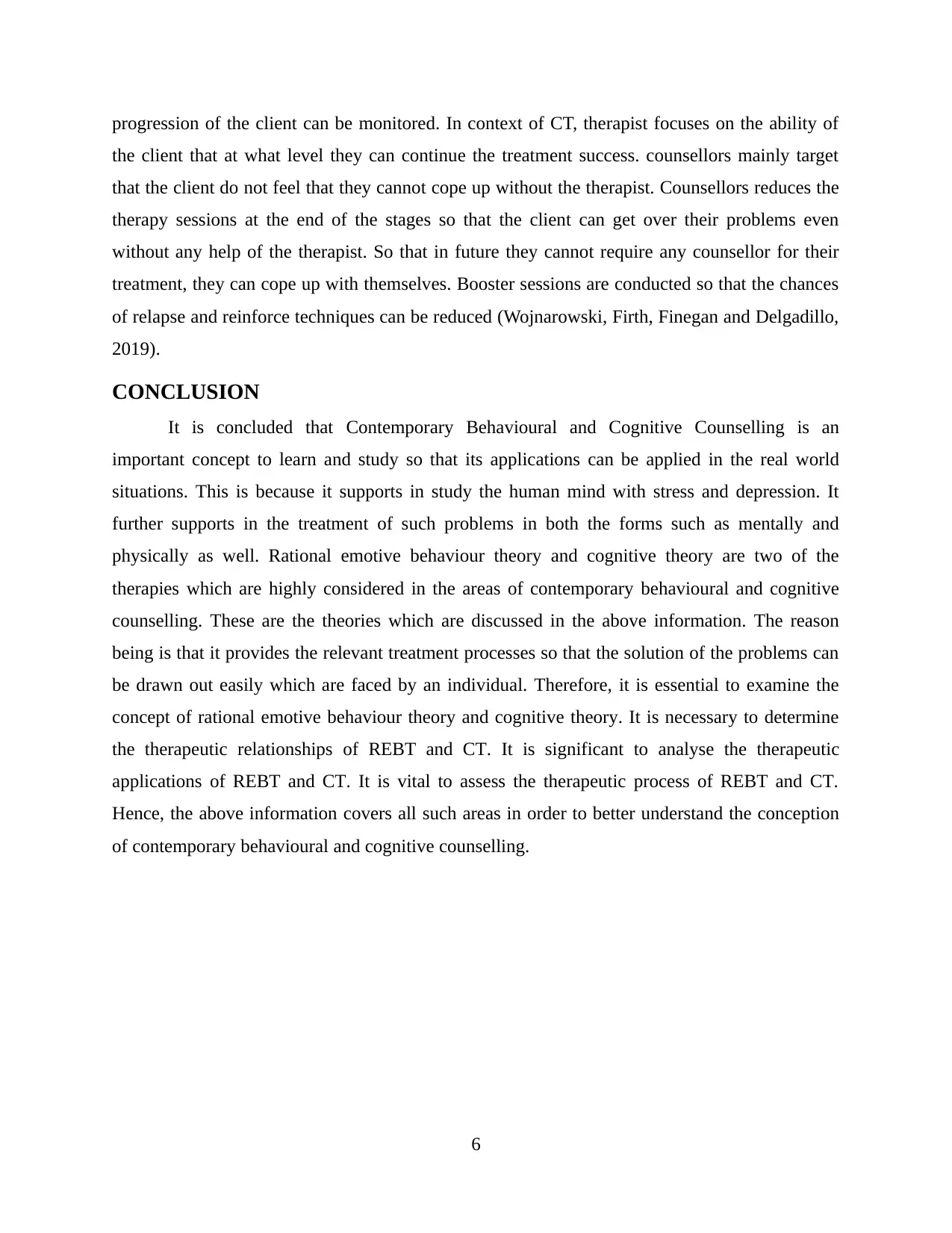
progression of the client can be monitored. In context of CT, therapist focuses on the ability of
the client that at what level they can continue the treatment success. counsellors mainly target
that the client do not feel that they cannot cope up without the therapist. Counsellors reduces the
therapy sessions at the end of the stages so that the client can get over their problems even
without any help of the therapist. So that in future they cannot require any counsellor for their
treatment, they can cope up with themselves. Booster sessions are conducted so that the chances
of relapse and reinforce techniques can be reduced (Wojnarowski, Firth, Finegan and Delgadillo,
2019).
CONCLUSION
It is concluded that Contemporary Behavioural and Cognitive Counselling is an
important concept to learn and study so that its applications can be applied in the real world
situations. This is because it supports in study the human mind with stress and depression. It
further supports in the treatment of such problems in both the forms such as mentally and
physically as well. Rational emotive behaviour theory and cognitive theory are two of the
therapies which are highly considered in the areas of contemporary behavioural and cognitive
counselling. These are the theories which are discussed in the above information. The reason
being is that it provides the relevant treatment processes so that the solution of the problems can
be drawn out easily which are faced by an individual. Therefore, it is essential to examine the
concept of rational emotive behaviour theory and cognitive theory. It is necessary to determine
the therapeutic relationships of REBT and CT. It is significant to analyse the therapeutic
applications of REBT and CT. It is vital to assess the therapeutic process of REBT and CT.
Hence, the above information covers all such areas in order to better understand the conception
of contemporary behavioural and cognitive counselling.
6
the client that at what level they can continue the treatment success. counsellors mainly target
that the client do not feel that they cannot cope up without the therapist. Counsellors reduces the
therapy sessions at the end of the stages so that the client can get over their problems even
without any help of the therapist. So that in future they cannot require any counsellor for their
treatment, they can cope up with themselves. Booster sessions are conducted so that the chances
of relapse and reinforce techniques can be reduced (Wojnarowski, Firth, Finegan and Delgadillo,
2019).
CONCLUSION
It is concluded that Contemporary Behavioural and Cognitive Counselling is an
important concept to learn and study so that its applications can be applied in the real world
situations. This is because it supports in study the human mind with stress and depression. It
further supports in the treatment of such problems in both the forms such as mentally and
physically as well. Rational emotive behaviour theory and cognitive theory are two of the
therapies which are highly considered in the areas of contemporary behavioural and cognitive
counselling. These are the theories which are discussed in the above information. The reason
being is that it provides the relevant treatment processes so that the solution of the problems can
be drawn out easily which are faced by an individual. Therefore, it is essential to examine the
concept of rational emotive behaviour theory and cognitive theory. It is necessary to determine
the therapeutic relationships of REBT and CT. It is significant to analyse the therapeutic
applications of REBT and CT. It is vital to assess the therapeutic process of REBT and CT.
Hence, the above information covers all such areas in order to better understand the conception
of contemporary behavioural and cognitive counselling.
6
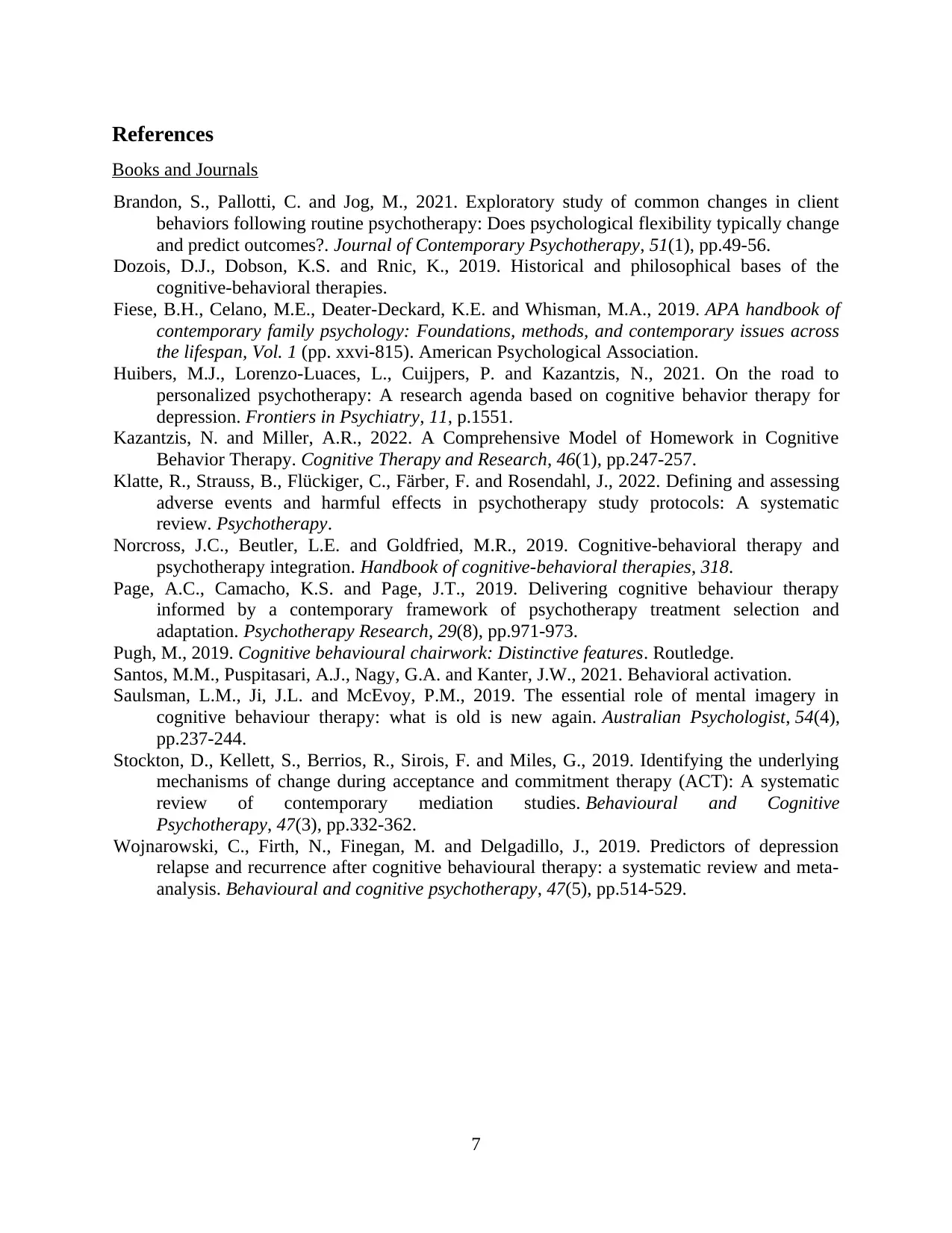
References
Books and Journals
Brandon, S., Pallotti, C. and Jog, M., 2021. Exploratory study of common changes in client
behaviors following routine psychotherapy: Does psychological flexibility typically change
and predict outcomes?. Journal of Contemporary Psychotherapy, 51(1), pp.49-56.
Dozois, D.J., Dobson, K.S. and Rnic, K., 2019. Historical and philosophical bases of the
cognitive-behavioral therapies.
Fiese, B.H., Celano, M.E., Deater-Deckard, K.E. and Whisman, M.A., 2019. APA handbook of
contemporary family psychology: Foundations, methods, and contemporary issues across
the lifespan, Vol. 1 (pp. xxvi-815). American Psychological Association.
Huibers, M.J., Lorenzo-Luaces, L., Cuijpers, P. and Kazantzis, N., 2021. On the road to
personalized psychotherapy: A research agenda based on cognitive behavior therapy for
depression. Frontiers in Psychiatry, 11, p.1551.
Kazantzis, N. and Miller, A.R., 2022. A Comprehensive Model of Homework in Cognitive
Behavior Therapy. Cognitive Therapy and Research, 46(1), pp.247-257.
Klatte, R., Strauss, B., Flückiger, C., Färber, F. and Rosendahl, J., 2022. Defining and assessing
adverse events and harmful effects in psychotherapy study protocols: A systematic
review. Psychotherapy.
Norcross, J.C., Beutler, L.E. and Goldfried, M.R., 2019. Cognitive-behavioral therapy and
psychotherapy integration. Handbook of cognitive-behavioral therapies, 318.
Page, A.C., Camacho, K.S. and Page, J.T., 2019. Delivering cognitive behaviour therapy
informed by a contemporary framework of psychotherapy treatment selection and
adaptation. Psychotherapy Research, 29(8), pp.971-973.
Pugh, M., 2019. Cognitive behavioural chairwork: Distinctive features. Routledge.
Santos, M.M., Puspitasari, A.J., Nagy, G.A. and Kanter, J.W., 2021. Behavioral activation.
Saulsman, L.M., Ji, J.L. and McEvoy, P.M., 2019. The essential role of mental imagery in
cognitive behaviour therapy: what is old is new again. Australian Psychologist, 54(4),
pp.237-244.
Stockton, D., Kellett, S., Berrios, R., Sirois, F. and Miles, G., 2019. Identifying the underlying
mechanisms of change during acceptance and commitment therapy (ACT): A systematic
review of contemporary mediation studies. Behavioural and Cognitive
Psychotherapy, 47(3), pp.332-362.
Wojnarowski, C., Firth, N., Finegan, M. and Delgadillo, J., 2019. Predictors of depression
relapse and recurrence after cognitive behavioural therapy: a systematic review and meta-
analysis. Behavioural and cognitive psychotherapy, 47(5), pp.514-529.
7
Books and Journals
Brandon, S., Pallotti, C. and Jog, M., 2021. Exploratory study of common changes in client
behaviors following routine psychotherapy: Does psychological flexibility typically change
and predict outcomes?. Journal of Contemporary Psychotherapy, 51(1), pp.49-56.
Dozois, D.J., Dobson, K.S. and Rnic, K., 2019. Historical and philosophical bases of the
cognitive-behavioral therapies.
Fiese, B.H., Celano, M.E., Deater-Deckard, K.E. and Whisman, M.A., 2019. APA handbook of
contemporary family psychology: Foundations, methods, and contemporary issues across
the lifespan, Vol. 1 (pp. xxvi-815). American Psychological Association.
Huibers, M.J., Lorenzo-Luaces, L., Cuijpers, P. and Kazantzis, N., 2021. On the road to
personalized psychotherapy: A research agenda based on cognitive behavior therapy for
depression. Frontiers in Psychiatry, 11, p.1551.
Kazantzis, N. and Miller, A.R., 2022. A Comprehensive Model of Homework in Cognitive
Behavior Therapy. Cognitive Therapy and Research, 46(1), pp.247-257.
Klatte, R., Strauss, B., Flückiger, C., Färber, F. and Rosendahl, J., 2022. Defining and assessing
adverse events and harmful effects in psychotherapy study protocols: A systematic
review. Psychotherapy.
Norcross, J.C., Beutler, L.E. and Goldfried, M.R., 2019. Cognitive-behavioral therapy and
psychotherapy integration. Handbook of cognitive-behavioral therapies, 318.
Page, A.C., Camacho, K.S. and Page, J.T., 2019. Delivering cognitive behaviour therapy
informed by a contemporary framework of psychotherapy treatment selection and
adaptation. Psychotherapy Research, 29(8), pp.971-973.
Pugh, M., 2019. Cognitive behavioural chairwork: Distinctive features. Routledge.
Santos, M.M., Puspitasari, A.J., Nagy, G.A. and Kanter, J.W., 2021. Behavioral activation.
Saulsman, L.M., Ji, J.L. and McEvoy, P.M., 2019. The essential role of mental imagery in
cognitive behaviour therapy: what is old is new again. Australian Psychologist, 54(4),
pp.237-244.
Stockton, D., Kellett, S., Berrios, R., Sirois, F. and Miles, G., 2019. Identifying the underlying
mechanisms of change during acceptance and commitment therapy (ACT): A systematic
review of contemporary mediation studies. Behavioural and Cognitive
Psychotherapy, 47(3), pp.332-362.
Wojnarowski, C., Firth, N., Finegan, M. and Delgadillo, J., 2019. Predictors of depression
relapse and recurrence after cognitive behavioural therapy: a systematic review and meta-
analysis. Behavioural and cognitive psychotherapy, 47(5), pp.514-529.
7
⊘ This is a preview!⊘
Do you want full access?
Subscribe today to unlock all pages.

Trusted by 1+ million students worldwide
1 out of 9
Related Documents
Your All-in-One AI-Powered Toolkit for Academic Success.
+13062052269
info@desklib.com
Available 24*7 on WhatsApp / Email
![[object Object]](/_next/static/media/star-bottom.7253800d.svg)
Unlock your academic potential
Copyright © 2020–2025 A2Z Services. All Rights Reserved. Developed and managed by ZUCOL.





